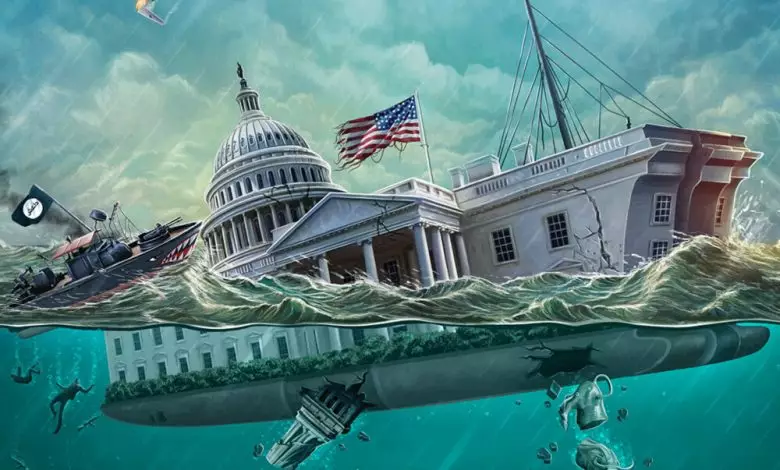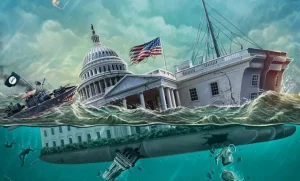The Divided States of America: dissection of the social gap in the United States

In an explanation on his book entitled “Identity” in Foreign Affairs March/April 2019 issue, Francis Fukuyama wrote: “Liberal democracy cannot exist without a national identity that defines what citizens hold in common with one another.”[1] Besides race and common identity origins, a common history is also the basis and foundation for the formation of any nation. However, as Dr. Jill Lepore, the author of the book “These Truths: A History of the United States”, rightly asked, when the United States first declared its independence in 1776, it turned into a government, but did anything turn it into a nation? According to her, long after independence, the majority of Americans considered the United States, not as a nation, but as the name implies, as a confederation of states.[2] The United States was formed by the presence of immigrants who had come to the new continent and who were from a different race and European (and then, Asian) nationalities and their entrance into this land was the origin of a history that was considered as “Conquest of Paradise” by the immigrants but as genocide, massacre and bloodshed by the indigenous.[3] In the subsequent periods, the arrival of Africans in the United States was the origin of a history that divided the inhabitants of this land into slaves and slaveholders.
The division reached its peak in the 19th century in the history of America. Besides the theft of the native Americans’ lands and forcing them to immigrate toward the west[4], besides the troubles, they brought to the blacks and slaves, as reflected in the “Uncle Tom’s Cabin” and with Harriet Tubman as their figure of rescue, the whites stood against one another on two sides of the history; General Robert Lee, on the one hand, and General Ulysses Grant, on the other, were the commanders in these civil wars. In 1848, John Calhoun, the American politician, introduced the American government as the “Government of White Men”. Another American politician Stephen Douglas declared ten years later that “this country was established by our fathers based on whiteness. It was built by white men and in favor of white men and their future generations.”[5] But Abraham Lincoln saw the key to victory in the opposition to this view and, as acknowledged by him, in the Emancipation Proclamation and freedom of the slaves. Though neither this proclamation nor the related amendment to the Constitution or dedication of the Statue of Liberty brought liberty to the slaves and the African Americans in the US.
In fact, this step led the dualities and disagreements to put down roots in American society in the next century. In the twentieth century, the Monroe Doctrine gradually faded out, and more attention was paid by the United States to its international role finally leading to intervention in World War II and Washington’s military, political and economic power becoming established. America’s efflorescence was so great that the term American Century[6] was coined leading to accelerated development of American facilities and capabilities in competition with the Soviet Union during the Cold War. Along with these developments, American society also moved forward and attempted to realize the slogans and ambitions it had heard of. The Civil Rights Movement turned the page in the divided history and this time racists were gradually pushed aside and the blacks gained some rights. But these developments were still full of confrontations and not directed at the realization of common goals. The collapse of the Soviet Union in the last decade in this century was so appealing to the spirit of American Exceptionalism that Francis Fukuyama referred to America’s being a superpower in a unipolar world after the Cold War as the “End of History”.
The early 21st century was the beginning of realism in different dimensions in the United States. The status of civil freedoms and racial and gender equality was such that Barack Obama admitted in his speech on the 50th Anniversary of Martin Luther King’s speech, that MLK’s “American Dream” has not been realized.[7] Ironically, what realized under a black president’s term in office was “I can’t breathe” and “Black lives matter” movements. The Occupy Wall Street Movement was formed as a protest against the social and economic discrimination resulting from the promises of capitalism and in the confrontation between banks and people’s house ownership. In his book “The New Class War”, Michael Lind believes that the American working class rose against small “Superclass” and “Managerial Elite” that accounts for 10-15% of the society but has a high effect on the ruling system, the scientific community and economy.[8] Nobel Economic Prize laureate Angus Deaton and Anne Case showed in their recent book “Deaths of Despair and the Future of Capitalism” how capitalism has made lives of people empty of philosophy and meaning and is orienting them toward tranquilizers, alcohol and drugs to cope with the stresses and strains of everyday life. This disparate approach has led to an increased rate of suicides and deaths caused by drug overdose, particularly among the white middle class.[9]
The sexual revolution and social freedoms led to reduced rates of marriage and increased rates of divorce and, more importantly, reduced birth rate in the United States. Ross Douthat, the author of “Decadent Society: How We Became the Victims of Our Own Success,”[10] and New York Times columnist, considers lower birth rates in the Western world, which is under the replacement level, along with political sclerosis, repetition in culture industry, lack of innovation in technology, etc. as pushing factors the American decline. The people who had heard of the Star Wars in the second half of the 20th century in cinemas and politics and cherished the dream of 2001: A Space Odyssey, are now faced with the problem of drinking water in Flint, Newark, Charleston and Milwaukee. In addition to piping, the roads, bridges, railroads and other infrastructures are also worn out. The infrastructural inefficiencies during the corona pandemic were revealed in the most obvious way. Although the American political atmosphere shifted all the blames for the problems caused by the corona pandemic onto the Trump administration, lack of hospital beds, lack of safety facilities and equipment for the health staff and lack of ventilators, etc. in all the states both Republican and Democrat, and, finally, theft of medical supplies from other countries were all indicative of America’s inability to meet the basic needs and security of its citizens. In an article in The Atlantic, George Packer described the status of America during the corona pandemic as a “Failed State”.[11] In his article in the Foreign Affairs Magazine[12], Dr. Amy Chua, the professor of law in Yale University and the author of ‘Political Tribes’, asserted that the corona pandemic revealed that the US is reaching the point of systemic failure. During this crisis, it seems more than ever before that this country is on the route to a violent political punishment.
At the national and international levels, the superpower that claimed it determined the fate of wars in the American Century was now facing the concept of Endless Wars and is still spending billions of dollars on these wars. The country without the intervention of which the Balkan conflicts would not have ended had no role to play in the political and military developments in Syria as one of the most strategic conflicts in today’s world politics. In the area of economy, America sees its position as weakened and is grappling with a fierce competitor called China. Giving up multilateralism and reduced international cooperation during Trump’s presidency further undermined American leadership role to the extent that Macron expressed his uncertainty and doubt[13] about Washington’s global leadership power and in the Munich Security Conference 2020, Westlessness[14] was the main theme of discussions focusing on the erosion of the western values and on the deviation of America and Europe from these ambitions and, consequently, other countries’ unwillingness to follow and become similar to them.
The distorted national identity and obvious contradictions between the realities of American society and ambitions and slogans in the previous decades have led to an identity crisis in America. The people who contradict the present conditions inevitably seek their identity in the past and the past has no common history and is full of contradictions and conflicts. For this reason, in his book, “Why We’re Polarized”, Ezra Klein considers partisan “mega-identities” as the most powerful force in the United States which overshadows other sources of identity. Today, Americans’ political identity has turned into a “Mega-Identity”. Other sources of identity such as race, religion, geography, etc. have been devoured by the labels ‘democrat’ and ‘republican’. Partisan mega-identities are the Engines of Polarization in society and the cause of the widest gap in the country, even much bigger than the racial gap. This partisan divide poses a grave danger.[15]
Although in the international arena, the issues of the decline of US power is viewed mainly from the perspective of its influence in global politics, military and economy, what is happening within the United States is in its domestic arena and its social layers. The chaos and unrest following George Floyd’s murder, the elections conflicts and, following that, the attack on the Congress building on January 6 are all the inevitable consequences of a social and polarization that has put down roots in this country for centuries. This is why Richard Haas considers the attack on the Capitol Hill, the symbol of the institution of democracy, as the beginning of “post-American” periods[16] and Francis Fukuyama warns that Americans are fracturing into segments based on ever-narrower identities and threaten the possibility of collective reflection and behavior by the society as a single unit, the result being “state breakdown and, ultimately, failure.”.[17]
[1] [1] https://www.foreignaffairs.com/articles/2019-02-01/stacey-abrams-response-to-francis-fukuyama-identity-politics-article#author-info
[2] https://www.foreignaffairs.com/articles/united-states/2019-02-05/new-americanism-nationalism-jill-lepore
[3] “A People’s History of the United States”, Howard Zinn, Harper Perennial Modern Classics, 2015.
[4] “Unworthy Republic: The Dispossession of Native Americans and the Road to Indian Territory”, Claudio Saunt, W. W. Norton & Company, 2020.
[5] https://www.foreignaffairs.com/articles/united-states/2019-02-05/new-americanism-nationalism-jill-lepore
[6] The term American Century was first used by Henry Luce in the Time Magazine to describe the role of America in the world policy, which became popular in the US political literature and policy making.
[7] https://edition.cnn.com/2013/08/28/politics/obama-king-speech-transcript/index.html
[8] The New Class War: Saving Democracy from the Managerial Elite”, Michael Lind, Portfolio / Penguin Publishing, 2020.
[9] Deaths of Despair and Future of Capitalism”, Angus Deaton & Anne Case, Princeton University Press, 2020.
[10] “Decadent Society: How We Became the Victims of Our Own Success”, Ross Douthat, Simon & Schuster, 2020.
[11] https://www.theatlantic.com/magazine/archive/2020/06/underlying-conditions/610261/
[12] https://www.foreignaffairs.com/reviews/review-essay/2020-06-01/divided-we-fall
[13] https://apnews.com/article/1cf7908da5bfc29d272e6dad34de0305
[14] https://securityconference.org/en/publications/munich-security-report-2020/
[15] “Why We’re Polarized”, Ezra Klein, Simon & Schuster, 2020.
[16] https://www.foreignaffairs.com/articles/united-states/2021-01-11/present-destruction
[17] ” Identity: The Demand for Dignity and the Politics of Resentment”, Francis Fukuyama, Farrar, Straus and Giroux, 2018.
Source: khamanei.ir





